Enhancement of Rosmarinic Acid Production in Hairy Root Cultures of Perovskia atriplicifolia Benth
Abstract
:1. Introduction
2. Results
2.1. Hairy Root Establishment and Transformation Confirmation
2.2. Growth Measurement of Hairy Root Clones
2.3. Phytochemical Studies
2.4. Expression of Genes Encoding Enzymes of the RA Biosynthetic Pathway
2.5. Culture Condition Optimization
3. Discussion
4. Materials and Methods
4.1. Plant Material
4.2. Establishment of Hairy Root Cultures
4.3. Confirmation of the Transformation
4.4. Hairy Root Cultivation
4.5. The Phytochemical Analysis
4.6. Gene Expression Analysis (RNA Extraction, Reverse Transcription, and Real-Time PCR (RT-PCR)
4.7. Optimization of Hairy Root Growth Condition
4.8. Data Analysis
5. Conclusions
Author Contributions
Funding
Institutional Review Board Statement
Informed Consent Statement
Data Availability Statement
Conflicts of Interest
References
- Pizzino, G.; Irrera, N.; Cucinotta, M.; Pallio, G.; Mannino, F.; Arcoraci, V.; Squadrito, F.; Altavilla, D.; Bitto, A. Oxidative stress: Harms and benefits for human health. Oxid. Med. Cell. Longev. 2017, 2017, 8416763. [Google Scholar] [CrossRef] [PubMed]
- Sharifi-Rad, M.; Anil Kumar, N.V.; Zucca, P.; Varoni, E.M.; Dini, L.; Panzarini, E.; Rejkovic, J.; Tsouh Fokou, P.V.; Azzini, E.; Peluso, I.; et al. Lifestyle, oxidative stress, and antioxidants: Back and forth in the pathophysiology of chronic diseases. Front. Physiol. 2020, 11, 694. [Google Scholar] [CrossRef]
- Pandey, K.B.; Rizvi, S.I. Plant polyphenols as dietary antioxidants in human health and disease. Oxid. Med. Cell. Longev. 2009, 2, 270–278. [Google Scholar] [CrossRef]
- Bulgakov, V.P.; Inyushkina, Y.V.; Fedoreyev, S.A. Rosmarinic acid and its derivatives: Biotechnology and applications. Crit. Rev. Biotechnol. 2012, 32, 203–217. [Google Scholar] [CrossRef]
- Scarpati, M.L.; Oriente, G. Isolamento e costituzione dell’acido rosmarinico (dal rosmarinus off.). Ric. Sci. 1958, 28, 2329–2333. [Google Scholar]
- Marchev, A.S.; Vasileva, L.V.; Amirova, K.M.; Savova, M.S.; Koycheva, I.K.; Balcheva-Sivenova, Z.P.; Vasileva, S.M.; Georgiev, M.I. Rosmarinic acid-from bench to valuable applications in food industry. Trends Food Sci. Technol. 2021, 117, 182–193. [Google Scholar] [CrossRef]
- Petersen, M. Rosmarinic acid: New aspects. Phytochem. Rev. 2013, 12, 207–227. [Google Scholar] [CrossRef]
- Kumar, N.; Reddy, M.P. In vitro plant propagation: A review. J. For. Environ. Sci. 2011, 27, 61–72. [Google Scholar] [CrossRef]
- Song, Z.; Li, X. Expression profiles of rosmarinic acid biosynthesis genes in two Salvia miltiorrhiza lines with differing water-soluble phenolic contents. Ind. Crops Prod. 2015, 71, 24–30. [Google Scholar] [CrossRef]
- Malarz, J.; Yudina, Y.V.; Stojakowska, A. Hairy root cultures as a source of phenolic antioxidants: Simple phenolics, phenolic acids, phenylethanoids, and hydroxycinnamates. Int. J. Mol. Sci. 2023, 24, 6920. [Google Scholar] [CrossRef]
- Krzemińska, M.; Owczarek, A.; Olszewska, M.A.; Grzegorczyk-Karolak, I. In vitro strategy for the enhancement of the production of bioactive polyphenols in transformed roots of Salvia bulleyana. Int. J. Mol. Sci. 2022, 23, 7771. [Google Scholar] [CrossRef]
- Murthy, H.N.; Lee, E.; Paek, K.Y. Production of secondary metabolites from cell and organ cultures: Strategies and approaches for biomass improvement and metabolite accumulation. Plant Cell Tissue Organ Cult. 2014, 118, 1–16. [Google Scholar] [CrossRef]
- Zhou, M.L.; Zhu, X.M.; Shao, J.R.; Tang, Y.X.; Wu, Y.M. Production and metabolic engineering of bioactive substances in plant hairy root culture. Appl. Microbiol. Biotechnol. 2011, 90, 1229–1239. [Google Scholar] [CrossRef] [PubMed]
- Marchev, A.; Haas, C.; Schulz, S.; Pavlov, A. Sage in vitro cultures: A promising tool for the production of bioactive terpenes and phenolic substances. Biotechnol. Lett. 2014, 36, 211–221. [Google Scholar] [CrossRef] [PubMed]
- Mohammadhosseini, M.; Venditti, A.; Akbarzadeh, A. The genus Perovskia Kar.: Ethnobotany, chemotaxonomy and phytochemistry: A review. Toxin Rev. 2019, 40, 484–505. [Google Scholar] [CrossRef]
- Gao, L.; Zhou, J.; Zhu, L.Y.; Zhang, J.R.; Jing, Y.X.; Zhao, J.W.; Huang, X.Z.; Li, G.P.; Jiang, Z.Y.; Xue, D.Y. Four new diterpene glucosides from Perovskia atriplicifolia. Chem. Biodivers. 2017, 14, e1700071. [Google Scholar] [CrossRef]
- Bielecka, M.; Pencakowski, B.; Stafiniak, M.; Jakubowski, K.; Rahimmalek, M.; Gharibi, S.; Matkowski, A.; Ślusarczyk, S. Metabolomics and DNA-based authentication of two traditional Asian medicinal and aromatic species of Salvia subg. Perovskia. Cells 2021, 10, 112. [Google Scholar] [CrossRef]
- Lloyd, G.; McCown, B. Commercially-feasible micropropagation of mountain laurel, Kalmia latifolia, by use of shoot-tip culture. International Plant Propagators’ Society 1980, 30, 421–427. [Google Scholar]
- Grzegorczyk-Karolak, I.; Krzemińska, M.; Kiss, A.K.; Olszewska, M.A.; Owczarek, A. Phytochemical profile and antioxidant activity of aerial and underground parts of Salvia bulleyana Diels. plants. Metabolites 2020, 10, 497. [Google Scholar] [CrossRef]
- Stanković, J.S.K.; Srećković, N.; Mišić, D.; Gašić, U.; Imbimbo, P.; Monti, D.M.; Mihailović, V. Bioactivity, biocompatibility and phytochemical assessment of lilac sage, Salvia verticillata L. (Lamiaceae)—A plant rich in rosmarinic acid. Ind. Crops Prod. 2020, 143, 111932. [Google Scholar] [CrossRef]
- Grzegorczyk-Karolak, I.; Kuźma, Ł.; Skała, E.; Kiss, A.K. Hairy root cultures of Salvia viridis L. for production of polyphenolic compounds. Ind. Crops Prod. 2018, 117, 235–244. [Google Scholar] [CrossRef]
- Wojciechowska, M.; Owczarek, A.; Kiss, A.K.; Grąbkowska, R.; Olszewska, M.A.; Grzegorczyk-Karolak, I. Establishment of hairy root cultures of Salvia bulleyana Diels for production of polyphenolic compounds. J. Biotechnol. 2020, 318, 10–19. [Google Scholar] [CrossRef]
- Martins, N.; Barros, L.; Santos-Buelga, C.; Henriques, M.; Silva, S.; Ferreira, I.C. Evaluation of bioactive properties and phenolic compounds in different extracts prepared from Salvia officinalis L. Food Chem. 2015, 170, 378–385. [Google Scholar] [CrossRef]
- Grzegorczyk-Karolak, I.; Krzemińska, M.; Grąbkowska, R.; Gomulski, J.; Żekanowski, C.; Gawęda-Walerych, K. Accumulation of polyphenols and associated gene expression in hairy roots of Salvia viridis exposed to methyl jasmonate. Int. J. Mol. Sci. 2024, 25, 764. [Google Scholar] [CrossRef]
- Schenk, R.U.; Hildebrandt, A.C. Medium and techniques for induction and growth of monocotyledonous and dicotyledonous plant cell cultures. Can. J. Bot. 1972, 50, 199–204. [Google Scholar] [CrossRef]
- Murashige, T.; Skoog, F. A revised medium for rapid growth and bioassays with tobacco tissue cultures. Physiol. Plant. 1962, 15, 473–497. [Google Scholar] [CrossRef]
- Gamborg, O.L.; Miller, R.A.; Ojina, K. Nutrient requirement of suspension cultures of soybean root cell. Exp. Cell Res. 1968, 50, 151–158. [Google Scholar] [CrossRef]
- Tiwari, R.; Trivedi, M.; Guang, Z.C.; Guo, G.Q.; Zheng, G.C. Agrobacterium rhizogenes mediated transformation of Scutellaria baicalensis and production of flavonoids in hairy roots. Biol. Plant. 2008, 52, 26–35. [Google Scholar] [CrossRef]
- Abadi, M.; Ganjeali, A.; Lahouti, M.; Moshtaghi, N. Influence of different Agrobacterium rhizogenes strains on hairy roots induction and secondary metabolites production in Ocimum basilicum L. J. Hortic. Sci. 2020, 34, 273–284. [Google Scholar] [CrossRef]
- Li, B.; Wang, B.; Li, H.; Peng, L.; Ru, M.; Liang, Z.; Yan, X.; Zhu, Y. Establishment of Salvia castanea Diels f. tomentosa Stib. hairy root cultures and the promotion of tanshinone accumulation and gene expression with Ag+, methyl jasmonate, and yeast extract elicitation. Protoplasma 2016, 253, 87–100. [Google Scholar] [CrossRef]
- Fraga, B.M.; Díaz, C.E.; Guadaño, A.; González-Coloma, A. Diterpenes from Salvia broussonetii transformed roots and their insecticidal activity. J. Agric. Food Chem. 2005, 53, 5200–5206. [Google Scholar] [CrossRef]
- Bauer, N.; Kiseljak, D.; Jelaska, S. The effect of yeast extract and methyl jasmonate on rosmarinic acid accumulation in Coleus blumei hairy roots. Biol. Plant. 2009, 53, 650–656. [Google Scholar] [CrossRef]
- Esmaeili, F.; Rahimi, Z.; Yousefian, S.; Farhadpour, M.; Lohrasebi, T. Comparative phenolic profile and antioxidant potential of mentha hairy roots and aerial parts. Biocatal. Agric. Biotechnol. 2025, 63, 103469. [Google Scholar] [CrossRef]
- Sathasivam, R.; Choi, M.; Radhakrishnan, R.; Kwon, H.; Yoon, J.; Yang, S.H.; Kim, J.K.; Chung, Y.S.; Park, S.U. Effects of various Agrobacterium rhizogenes strains on hairy root induction and analyses of primary and secondary metabolites in Ocimum basilicum. Front. Plant Sci. 2022, 13, 983776. [Google Scholar] [CrossRef]
- Khoshsokhan, F.; Babalar, M.; Salami, S.A.; Sheikhakbari-Mehr, R.; Mirjalili, M.H. Rosmarinic acid production in hairy root cultures of Salvia nemorosa L. (Lamiaceae). Biocatal. Agric. Biotechnol. 2022, 45, 102494. [Google Scholar] [CrossRef]
- Grzegorczyk, I.; Królicka, A.; Wysokińska, H. Establishment of Salvia officinalis L. hairy root cultures for the production of rosmarinic acid. Z. Naturforsch. C 2006, 61, 351–356. [Google Scholar] [CrossRef]
- Ebrahimi, S.; Zaker, A.; Abrishamchi, P.; Bahrami, A.R.; Ganjeali, A.; Sodagar, N. Hairy root induction and secondary metabolite production in Perovskia abrotanoides Karel. J. Plant Process Funct. 2017, 6, 17–26. [Google Scholar]
- Smetanska, I. Sustainable production of polyphenols and antioxidants by plant in vitro cultures. In Bioprocessing of Plant In Vitro Systems; Reference Series in Phytochemistry; Pavlov, A., Bley, T., Eds.; Springer: Cham, Switzerland, 2018; pp. 225–269. [Google Scholar] [CrossRef]
- Attaran Dowom, S.; Abrishamchi, P.; Radjabian, T.; Salami, S.A. Elicitor-induced phenolic acids accumulation in Salvia virgata Jacq. hairy root cultures. Plant Cell Tissue Organ Cult. 2022, 148, 107–117. [Google Scholar] [CrossRef]
- Chaudhuri, K.N.; Ghosh, B.; Tepfer, D.; Jha, S. Genetic transformation of Tylophora indica with Agrobacterium rhizogenes A4: Growth and tylophorine productivity in different transformed root clones. Plant Cell Rep. 2005, 24, 25–35. [Google Scholar] [CrossRef]
- Georgiev, M.I.; Ludwig-Müller, J.; Alipieva, K.; Lippert, A. Sonication-assisted Agrobacterium rhizogenes-mediated transformation of Verbascum xanthophoeniceum Griseb. for bioactive metabolite accumulation. Plant Cell Rep. 2011, 30, 859–866. [Google Scholar] [CrossRef]
- Guillon, S.; Trémouillaux-Guiller, J.; Pati, P.K.; Rideau, M.; Gantet, P. Hairy root research: Recent scenario and exciting prospects. Curr. Opin. Plant Biol. 2006, 9, 341–346. [Google Scholar] [CrossRef]
- Pietrosiuk, A.; Furmanova, M.; Lata, B. Catharanthus roseus: Micropropagation and in vitro techniques. Phytochem. Rev. 2007, 6, 459–473. [Google Scholar] [CrossRef]
- Giri, A.; Narasu, M.L. Transgenic hairy roots: Recent trends and applications. Biotechnol. Adv. 2000, 18, 1–22. [Google Scholar] [CrossRef]
- Taneja, J.; Jaggi, M.; Wankhede, D.P.; Sinha, A.K. Effect of loss of T-DNA genes on MIA biosynthetic pathway gene regulation and alkaloid accumulation in Catharanthus roseus hairy roots. Plant Cell Rep. 2010, 29, 1119–1129. [Google Scholar] [CrossRef]
- Song, J.; Wang, Z. RNAi-mediated suppression of the phenylalanine ammonia-lyase gene in Salvia miltiorrhiza causes abnormal phenotypes and a reduction in rosmarinic acid biosynthesis. J. Plant Res. 2011, 124, 183–192. [Google Scholar] [CrossRef]
- Szabo, E.; Thelen, A.; Petersen, M. Fungal elicitor preparations and methyl jasmonate enhance rosmarinic acid accumulation in suspension cultures of Coleus blumei. Plant Cell Rep. 1999, 18, 485–489. [Google Scholar] [CrossRef]
- Mizukami, H.; Ogawa, T.; Ellis, B.E. Induction of rosmarinic acid biosynthesis in Lithospermum erythrorhizon cell suspension cultures by yeast extract. Plant Cell Rep. 1992, 11, 480–483. [Google Scholar] [CrossRef]
- Ru, M.; Li, Y.; Guo, M.; Chen, L.; Tan, Y.; Peng, L.; Liang, Z. Increase in rosmarinic acid accumulation and transcriptional responses of synthetic genes in hairy root cultures of Prunella vulgaris induced by methyl jasmonate. Plant Cell Tissue Organ Cult. 2022, 149, 371–379. [Google Scholar] [CrossRef]
- Yan, Q.; Shi, M.; Ng, J.; Wu, J.Y. Elicitor-induced rosmarinic acid accumulation and secondary metabolism enzyme activities in Salvia miltiorrhiza hairy roots. Plant Sci. 2006, 170, 853–858. [Google Scholar] [CrossRef]
- Xiao, Y.; Zhang, L.; Gao, S.; Saechao, S.; Di, P.; Chen, J.; Chen, W. The c4h, tat, hppr and hppd genes prompted engineering of rosmarinic acid biosynthetic pathway in Salvia miltiorrhiza hairy root cultures. PLoS ONE 2011, 6, e29713. [Google Scholar] [CrossRef]
- Blount, J.W.; Korth, K.L.; Masoud, S.A.; Rasmussen, S.; Lamb, C.; Dixon, R.A. Altering expression of cinnamic acid 4-hydroxylase in transgenic plants provides evidence for a feedback loop at the entry point into the phenylpropanoid pathway. Plant Physiol. 2000, 122, 107–116. [Google Scholar] [CrossRef] [PubMed]
- Mavandad, M.; Edwards, R.; Liang, X.; Lamb, C.J.; Dixon, R.A. Effects of trans-cinnamic acid on expression of the bean phenylalanine ammonia-lyase gene family. Plant Physiol. 1990, 94, 671–680. [Google Scholar] [CrossRef]
- Shinde, A.N.; Malpathak, N.; Fulzele, D.P. Impact of nutrient components on production of the phytoestrogens daidzein and genistein by hairy roots of Psoralea corylifolia. J. Nat. Med. 2010, 64, 346–353. [Google Scholar] [CrossRef]
- Choi, M.; Yoon, J.; Yang, S.H.; Kim, J.K.; Park, S.U. Production of phenolic compounds and antioxidant activity in hairy root cultures of Salvia plebeia. Plants 2023, 12, 3840. [Google Scholar] [CrossRef]
- Yamakawa, T.; Kato, S.; Ishida, K.; Kodama, T.; Minoda, Y. Production of anthocyanins by Vitis cells in suspension culture. Agric. Biol. Chem. 1983, 47, 2185–2191. [Google Scholar] [CrossRef]
- Danaraj, J.; Mariasingarayan, Y.; Periakaruppan, R.; Krishna, J.; Raja, M.; Ayyappan, S.; Sivaramakrishnan, R.; Incharoensakdi, A. Phenylpropanoid biosynthetic gene expression and nutrient uptake kinetics for enhanced rosmarinic acid production in suspension cultured cells of Halodule pinifolia. Algal Res. 2022, 64, 102675. [Google Scholar] [CrossRef]
- Grzegorczyk-Karolak, I. Optimization of culture conditions and cultivation phase for the growth of Salvia viridis transformed roots and polyphenolic compound production. Plant Cell Tissue Organ Cult. 2020, 142, 571–581. [Google Scholar] [CrossRef]
- Lee, S.Y.; Xu, H.; Kim, Y.K.; Park, S.U. Rosmarinic acid production in hairy root cultures of Agastache rugosa Kuntze. World J. Microbial. Biotechnol. 2008, 24, 969–972. [Google Scholar] [CrossRef]
- Lee, S.Y.; Lee, C.Y.; Eom, S.H.; Kim, Y.K.; Park, N.; Park, S.U. Rosmarinic acid production from transformed root cultures of Nepeta cataria L. Sci. Res. Essays 2010, 5, 1122–1126. [Google Scholar]
- Xiao, Y.; Gao, S.; Di, P.; Chen, J.; Chen, W.; Zhang, L. Lithospermic acid B is more responsive to silver ions (Ag+) than rosmarinic acid in Salvia miltiorrhiza hairy root cultures. Biosci. Rep. 2010, 30, 33–40. [Google Scholar] [CrossRef]
- Bais, H.P.; Walker, T.S.; Schweizer, H.P.; Vivanco, J.M. Root specific elicitation and antimicrobial activity of rosmarinic acid in hairy root cultures of Ocimum basilicum. Plant Physiol. Biochem. 2002, 40, 983–995. [Google Scholar] [CrossRef]
- Weremczuk-Jeżyna, I.; Skała, E.; Olszewska, M.A.; Kiss, A.K.; Balcerczak, E.; Wysokińska, H.; Kicel, A. The identification and quantitative determination of rosmarinic acid and salvianolic acid B in hairy root cultures of Dracocephalum forrestii W.W. Smith. Ind. Crops Prod. 2016, 91, 125–131. [Google Scholar] [CrossRef]
- Khodadadi, F.; Ahmadi, F.S.; Talebi, M.; Matkowski, A.; Szumny, A.; Afshari, M.; Rahimmalek, M. Metabolic and transcriptomic approaches of chitosan and water stress on polyphenolic and terpenoid components and gene expression in Salvia abrotanoides (Karl.) and S. yangii. Int. J. Mol. Sci. 2023, 24, 15426. [Google Scholar] [CrossRef] [PubMed]
- Stafiniak, M.; Ślusarczyk, S.; Pencakowski, B.; Matkowski, A.; Rahimmalek, M.; Bielecka, M. Seasonal variations of rosmarinic acid and its glucoside and expression of genes related to their biosynthesis in two medicinal and aromatic species of Salvia subg. Perovskia. Biology 2021, 10, 458. [Google Scholar] [CrossRef]
- Flora of China/Flora of Pakistan. Available online: http://www.efloras.org/florataxon.aspx?flora_id (accessed on 12 February 2025).
- Hooykaas, P.J.J.; Klapwijk, P.M.; Nuti, M.P.; Schilperoot, R.A.; Rörsch, A. Transfer of the Agrobacterium tumefaciens Ti plasmid to avirulent Agrobacteria and to Rhizobium ex planta. J. Gen. Microbiol. 1977, 98, 477–484. [Google Scholar] [CrossRef]
- Skała, E.; Kicel, A.; Olszewska, M.; Kiss, A.; Wysokińska, H. Establishment of hairy root cultures of Rhaponticum carthamoides (Willd.) Iljin for the production of biomass and caffeic acid derivatives. BioMed Res. Int. 2015, 2015, e181098. [Google Scholar] [CrossRef]
- Grzegorczyk-Karolak, I.; Ejsmont, W.; Kiss, A.K.; Tabaka, P.; Starbała, W.; Krzemińska, M. Improvement of bioactive polyphenol accumulation in callus of Salvia atropatana Bunge. Molecules 2024, 29, 2626. [Google Scholar] [CrossRef]
- Metsalu, T.; Vilo, J. Clustvis: A web tool for visualizing clustering of multivariate data using Principal Component Analysis and heatmap. Nucleic Acids Res. 2015, 43, W566–W570. [Google Scholar] [CrossRef]
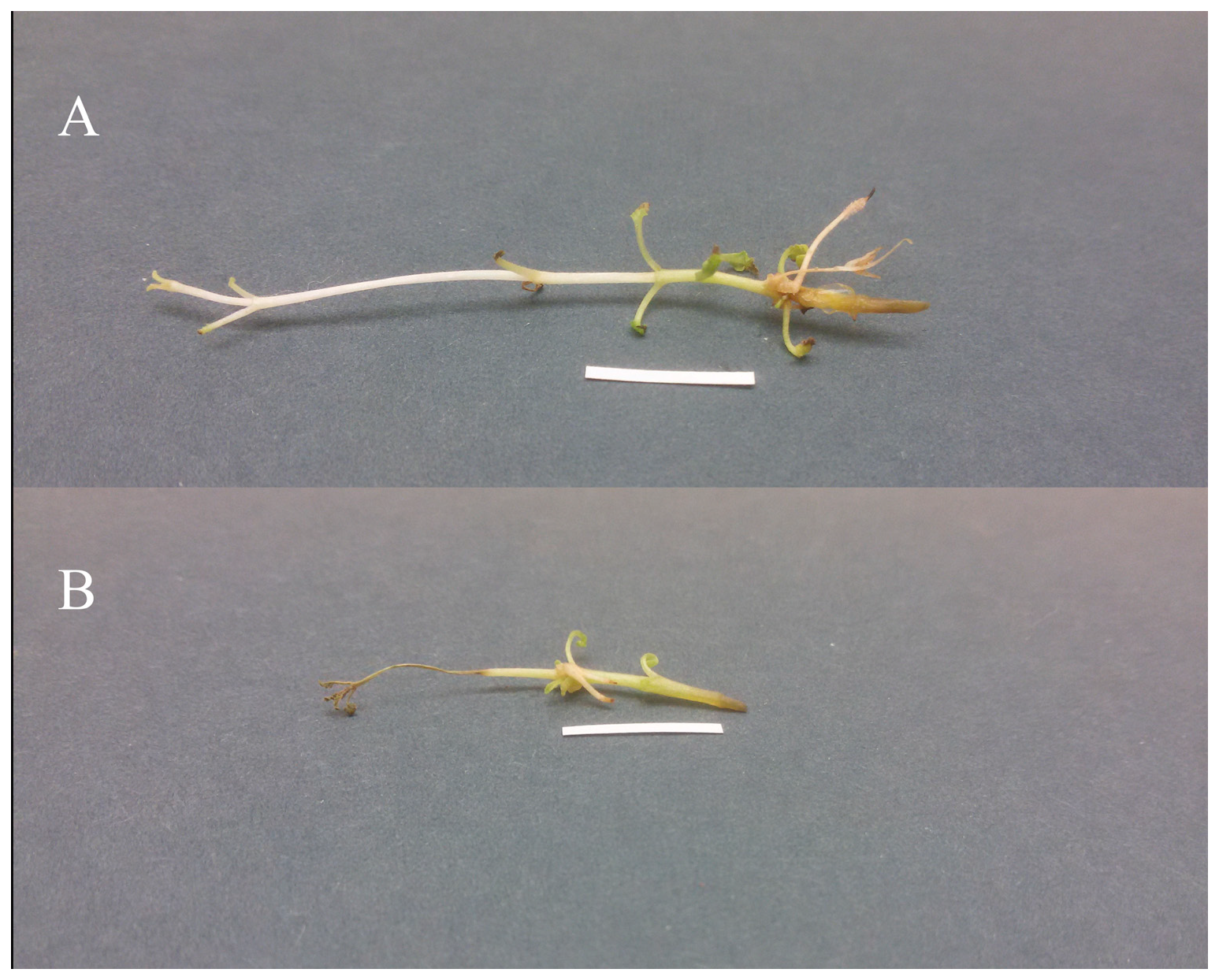

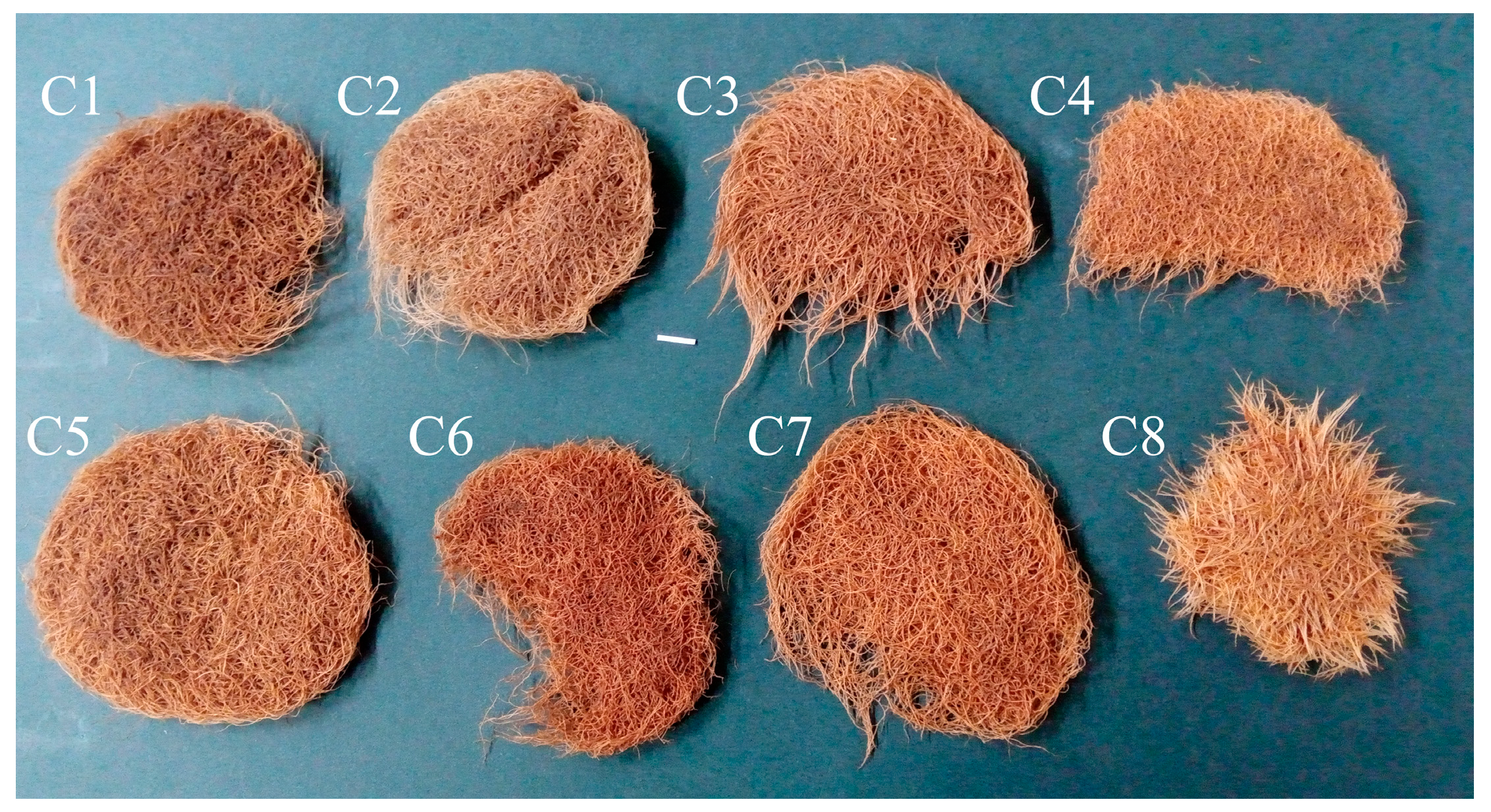
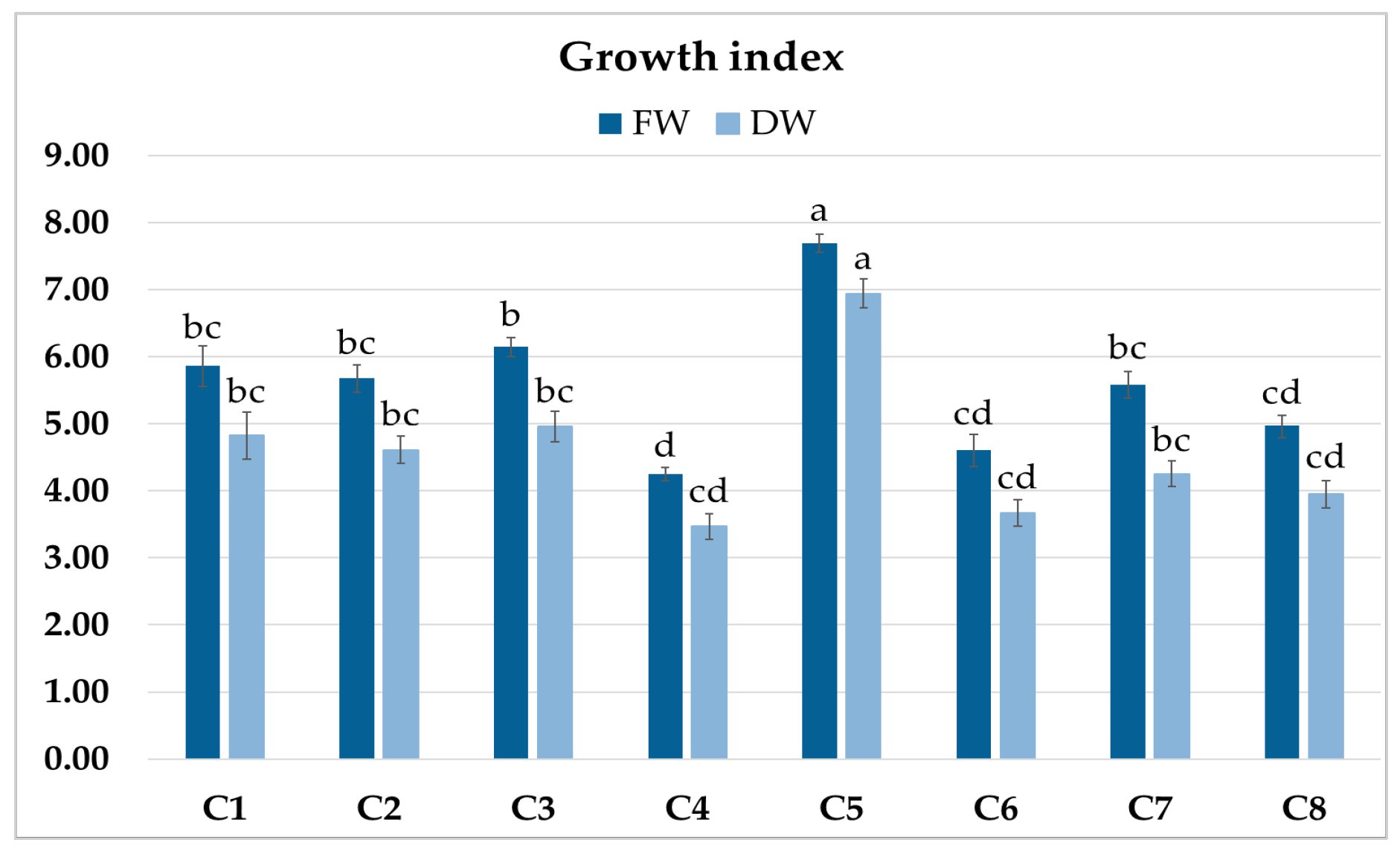



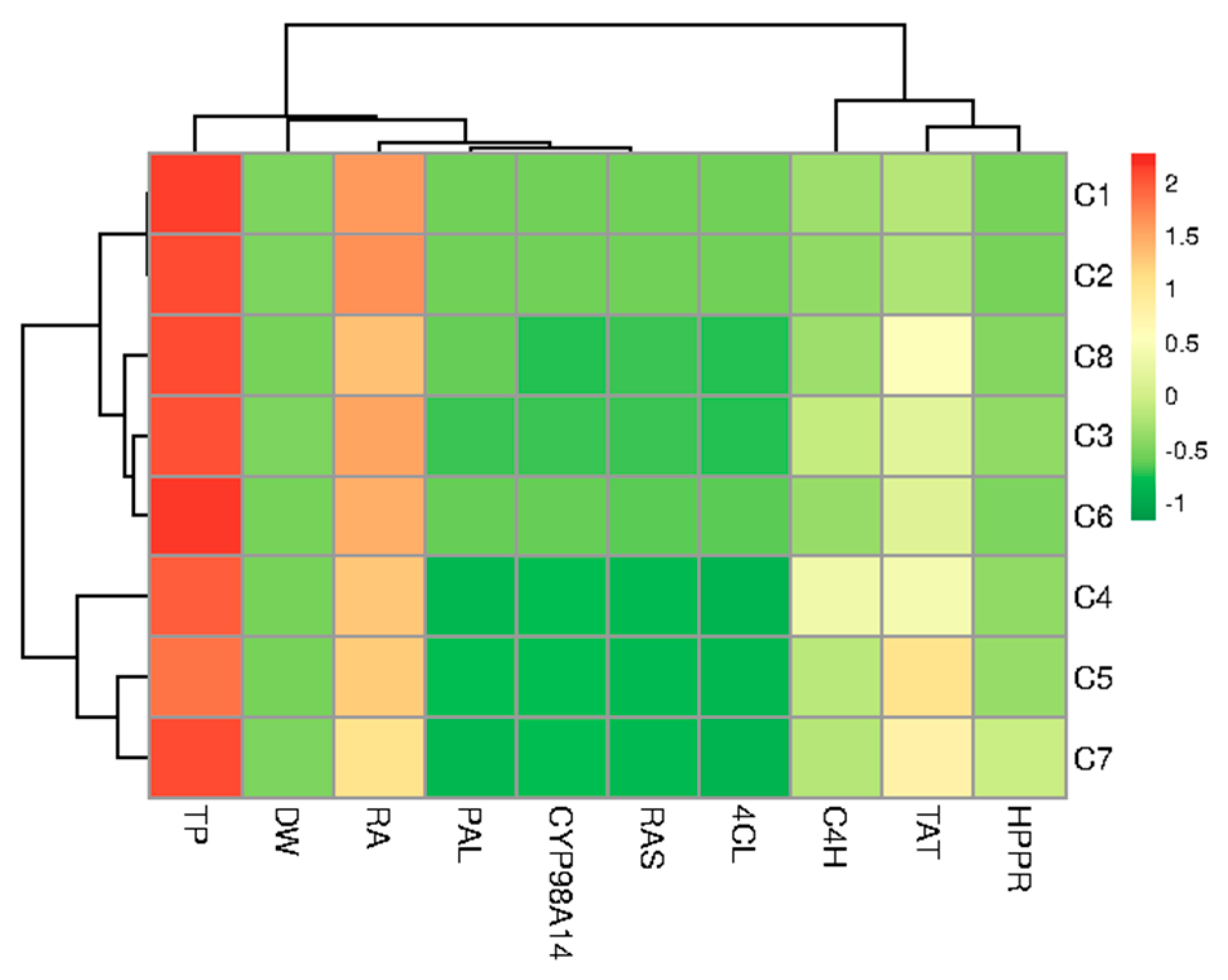
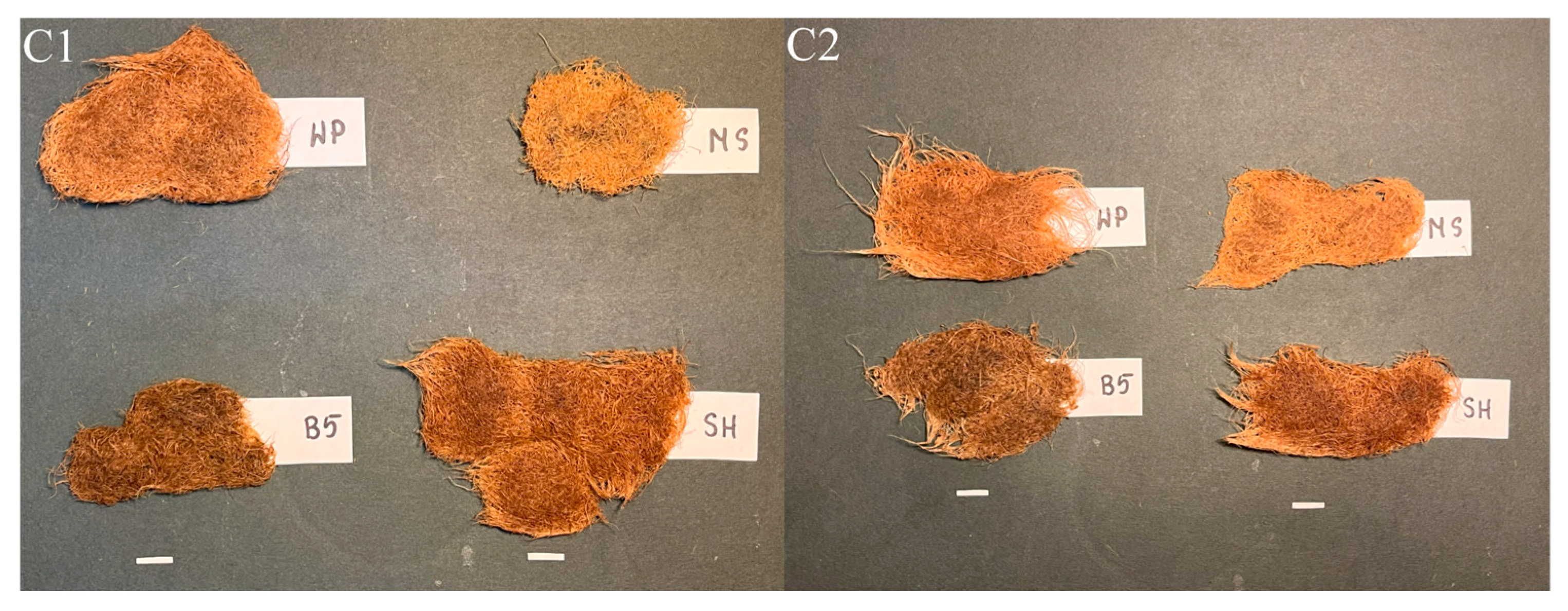

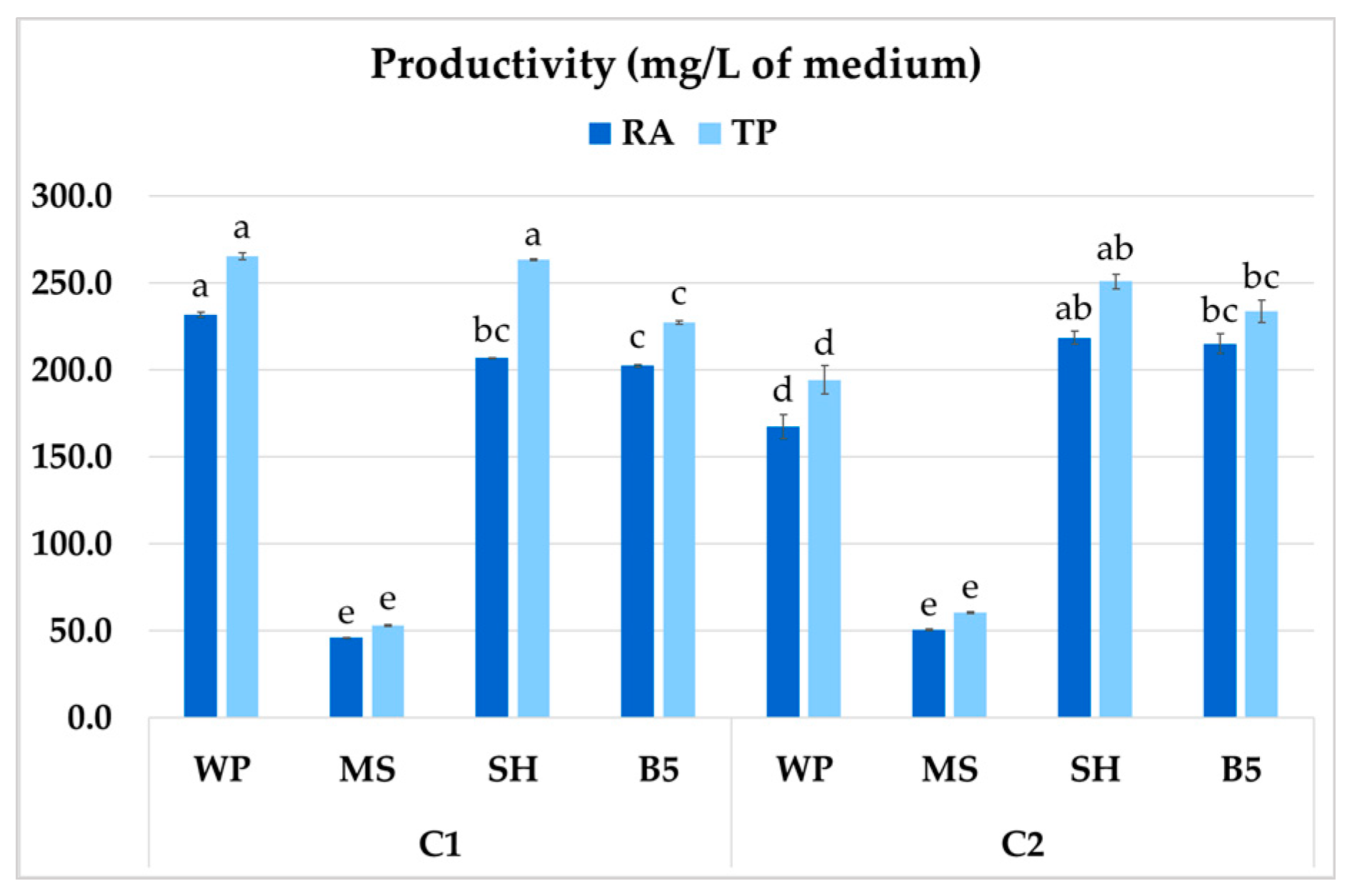
| Bacterial Strain | Number of Explants | Explants Forming Roots (%) | Mean Number of Roots/Explants | Mean Length of Roots (cm) |
|---|---|---|---|---|
| A4 | 63 | 41.3 ± 3.0 a | 2.5 ± 0.34 a | 0.77 ± 0.08 a |
| ATCC 15834 | 53 | 30.2 ± 1.0 b | 2.5 ± 0.37 a | 0.67 ± 0.10 a |
| Clone | aux1 (500 bp) | aux2 (774 bp) | rolB (386 bp) | rolC (582 bp) | rolD (204 bp) |
|---|---|---|---|---|---|
| C1 | + | + | + | + | + |
| C2 | + | + | + | + | + |
| C3 | + | + | + | − | + |
| C4 | − | + | + | + | + |
| C5 | + | + | + | + | + |
| C6 | − | + | + | + | + |
| C7 | + | + | + | + | + |
| C8 | + | + | + | + | + |
| Peak No. | Rt | [M-H]− | Main Fragments | Tentative Compound |
|---|---|---|---|---|
| 1 | 18.9 | 503 | 341, 281, 251, 179 | Caffeic acid dihexoside |
| 2 | 21.8 | 179 | 135 | Caffeic acid |
| 3 | 27.9 | 357 | 313, 269, 203 | Prolithospermic acid |
| 4 | 36.4 | 717 | 519, 475, 365, 339 | Salvianolic acid isomer |
| 5 | 39.7 | 359 | 223, 197, 179, 161 | Rosmarinic acid |
| 6 | 53.6 | 313 | 269, 161 | Salvianolic acid F isomer I |
| 7 | 56.6 | 313 | 269, 203, 161 | Salvianolic acid F isomer II |
| C1 | C2 | C3 | C4 | C5 | C6 | C7 | C8 | |
|---|---|---|---|---|---|---|---|---|
| CA | 0.592 ± 0.005 b | 0.443 ± 0.005 cd | 0.333 ± 0.005 f | 0.323 ± 0.003 f | 0.464 ± 0.005 c | 0.701 ± 0.011 a | 0.414 ± 0.002 e | 0.428 ± 0.003 de |
| PLS | 0.101 ± 0.001 a | 0.109 ± 0.003 a | 0.057 ± 0.001 c | 0.012 ± 0.001 d | 0.084 ± 0.005 b | 0.105 ± 0.002 a | 0.078 ± 0.002 b | 0.058 ± 0.003 c |
| SAI | 0.719 ± 0.006 a | 0.628 ± 0.005 c | 0.335 ± 0.005 d | 0.357 ± 0.003 d | 0.293 ± 0.002 e | 0.690 ± 0.013 b | 0.296 ± 0.004 e | 0.160 ± 0.002 f |
| RA | 13.6 ± 0.093 b | 15.90 ± 0.080 a | 6.67 ± 0.136 d | 3.31 ± 0.023 g | 5.39 ± 0.041 e | 8.28 ± 0.124 c | 3.22 ± 0.054 g | 3.73 ± 0.061 f |
| SAF I | 0.449 ± 0.008 b | 0.381 ± 0.009 c | 0.161 ± 0.006 f | 0.084 ± 0.002 g | 0.134 ± 0.004 f | 0.576 ± 0.014 a | 0.278 ± 0.006 d | 0.237 ± 0.002 e |
| SAF II | 1.52 ± 0.017 a | 1.15 ± 0.004 c | 0.685 ± 0.012 d | 0.312 ± 0.001 g | 0.552 ± 0.009 e | 1.25 ± 0.023 b | 0.666 ± 0.004 d | 0.467 ± 0.004 f |
| TP | 17.0 ± 0.123 b | 18.6 ± 0.088 a | 8.24 ± 0.162 d | 4.40 ± 0.026 g | 6.92 ± 0.047 e | 11.6 ± 0.175 c | 4.94 ± 0.059 f | 5.08 ± 0.072 f |
| Clone | C1 | C2 | ||||||
|---|---|---|---|---|---|---|---|---|
| Medium | WP | MS | SH | B5 | WP | MS | SH | B5 |
| CA | 0.839 ± 0.016 a | 0.224 ± 0.000 e | 0.738 ± 0.006 b | 0.573 ± 0.005 c | 0.640 ± 0.025 c | 0.380 ± 0.005 d | 0.588 ± 0.011 c | 0.422 ± 0.012 d |
| PLS | 0.142 ± 0.005 de | 0.040 ± 0.002 f | 0.154 ± 0.001 cd | 0.212 ± 0.003 b | 0.167 ± 0.003 c | 0.130 ± 0.005 e | 0.125 ± 0.001 e | 0.257 ± 0.007 a |
| SAI | 0.932 ± 0.010 bc | 0.106 ± 0.002 f | 1.01 ± 0.012 b | 0.444 ± 0.006 d | 0.994 ± 0.052 b | 0.207 ± 0.003 e | 1.28 ± 0.015 a | 0.884 ± 0.028 c |
| RA | 26.80 ± 0.183 c | 9.48 ± 0.051 f | 20.00 ± 0.033 e | 38.31 ± 0.164 b | 22.60 ± 0.933 d | 11.00 ± 0.121 f | 26.80 ± 0.454 c | 40.84 ± 1.06 a |
| SAF I | 0.282 ± 0.023 b | 0.278 ± 0.007 b | 0.804 ± 0.002 a | 0.859 ± 0.015 a | 0.245 ± 0.028 b | 0.229 ± 0.009 b | 0.273 ± 0.014 b | 0.275 ± 0.032 b |
| SAF II | 1.71 ± 0.022 b | 0.807 ± 0.026 d | 2.74 ± 0.009 a | 2.65 ± 0.033 a | 1.58 ± 0.069 b | 1.24 ± 0.019 c | 1.69 ± 0.041 b | 1.66 ± 0.087 b |
| TP | 30.7 ± 0.212 b | 10.9 ± 0.085 d | 25.4 ± 0.047 c | 43.1 ± 0.223 a | 26.2 ± 1.09 c | 13.2 ± 0.156 d | 30.8 ± 0.533 b | 44.3 ± 1.21 a |
Disclaimer/Publisher’s Note: The statements, opinions and data contained in all publications are solely those of the individual author(s) and contributor(s) and not of MDPI and/or the editor(s). MDPI and/or the editor(s) disclaim responsibility for any injury to people or property resulting from any ideas, methods, instructions or products referred to in the content. |
© 2025 by the authors. Licensee MDPI, Basel, Switzerland. This article is an open access article distributed under the terms and conditions of the Creative Commons Attribution (CC BY) license (https://creativecommons.org/licenses/by/4.0/).
Share and Cite
Grąbkowska, R.; Krzemińska, M.; Gaweda-Walerych, K.; Kiss, A.K.; Pluta, K.; Grzegorczyk-Karolak, I. Enhancement of Rosmarinic Acid Production in Hairy Root Cultures of Perovskia atriplicifolia Benth. Int. J. Mol. Sci. 2025, 26, 3187. https://doi.org/10.3390/ijms26073187
Grąbkowska R, Krzemińska M, Gaweda-Walerych K, Kiss AK, Pluta K, Grzegorczyk-Karolak I. Enhancement of Rosmarinic Acid Production in Hairy Root Cultures of Perovskia atriplicifolia Benth. International Journal of Molecular Sciences. 2025; 26(7):3187. https://doi.org/10.3390/ijms26073187
Chicago/Turabian StyleGrąbkowska, Renata, Marta Krzemińska, Katarzyna Gaweda-Walerych, Anna Karolina Kiss, Kamila Pluta, and Izabela Grzegorczyk-Karolak. 2025. "Enhancement of Rosmarinic Acid Production in Hairy Root Cultures of Perovskia atriplicifolia Benth" International Journal of Molecular Sciences 26, no. 7: 3187. https://doi.org/10.3390/ijms26073187
APA StyleGrąbkowska, R., Krzemińska, M., Gaweda-Walerych, K., Kiss, A. K., Pluta, K., & Grzegorczyk-Karolak, I. (2025). Enhancement of Rosmarinic Acid Production in Hairy Root Cultures of Perovskia atriplicifolia Benth. International Journal of Molecular Sciences, 26(7), 3187. https://doi.org/10.3390/ijms26073187






